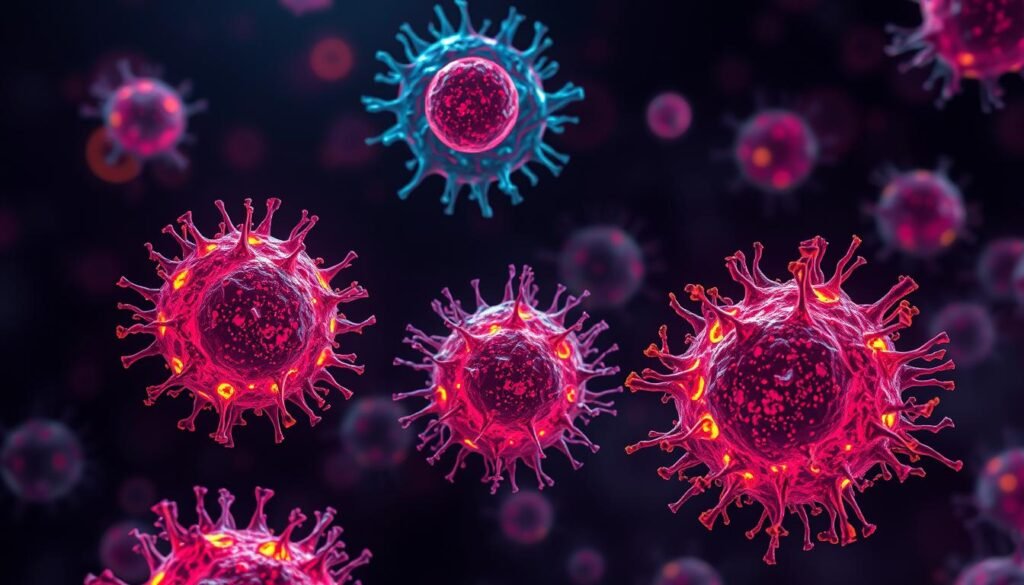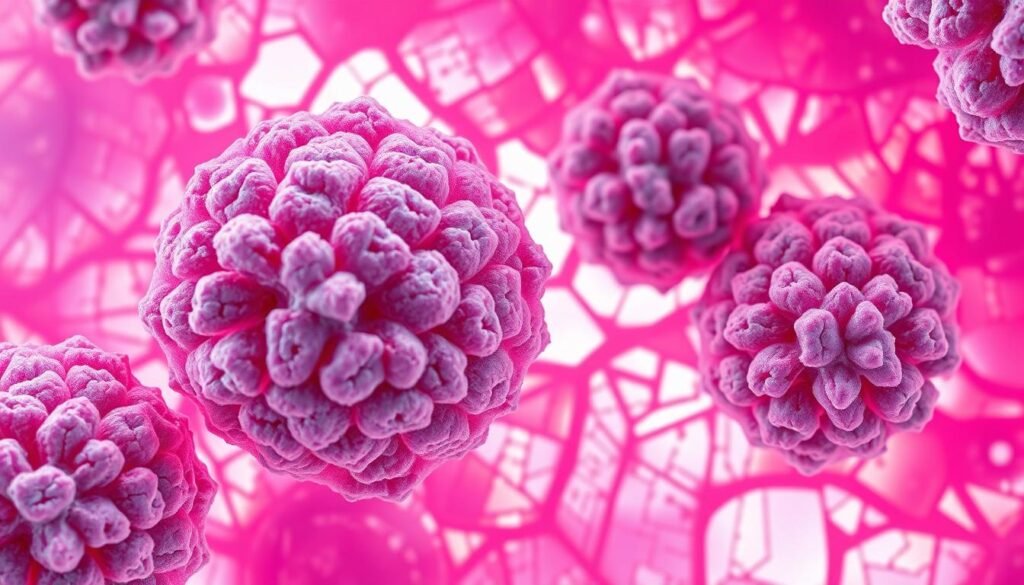Non-small cell lung cancer (NSCLC) is the main type of lung cancer, making up over 95% of cases. But, did you know there are rare kinds too? Every year, around 225,000 people in the U.S. find out they have lung cancer. Learning about the rare types of NSCLC is crucial. It could greatly help patients.
Adenocarcinoma and squamous cell carcinoma are the most common, affecting 60% of NSCLC patients. However, there are other rare forms of lung cancer that are not as well known. This article explores these uncommon types. We’ll look at their special features, why they’re hard to diagnose, and how treatment can improve patient care.
Key Takeaways
- NSCLC constitutes more than 95% of lung cancer cases in the U.S.
- Common types of NSCLC include adenocarcinoma and squamous cell carcinoma.
- Rare forms of NSCLC can significantly influence treatment approaches.
- Adenosquamous and large cell carcinoma are among the uncommon subtypes.
- Understanding rare NSCLC types can enhance diagnosis and patient care.
- Early recognition of unusual lung cancers leads to better management strategies.
Understanding Non-Small Cell Lung Cancer (NSCLC)
Non-small cell lung cancer, or NSCLC, is the most common lung cancer type. It makes up about 80% to 85% of all cases. NSCLC grows more slowly than small cell lung cancer. Different lung cells can be the starting point of this cancer. Knowing the type of lung cancer is key to choosing the best treatment.
NSCLC has three main kinds: adenocarcinoma, squamous cell carcinoma, and large cell carcinoma. Adenocarcinoma is usually found in the lung’s outer parts and is the most common. Squamous cell carcinoma starts near the bronchi. Large cell carcinoma is less common but grows faster.
The main risk factor for NSCLC is smoking. Secondhand smoke, asbestos, radiation, and pollution also increase the risk. Getting older can raise the risk of lung cancer too.
If you know the signs of NSCLC, you can catch it early. Look out for ongoing coughing, trouble breathing, blood when coughing, a hoarse voice, and losing weight without trying. Doctors use tests like blood work, chest X-rays, CT scans, and biopsies to diagnose it.
How early NSCLC is found affects treatment and chances of a good outcome. Each case needs careful consideration. For more info on lung cancer types, visit this resource here.
Common Types of NSCLC Overview
Non-small cell lung cancer (NSCLC) includes a few main types: adenocarcinoma, squamous cell carcinoma, and large cell carcinoma. Around 85% of lung cancer cases in the U.S. fall under these categories. They are vital for understanding how lung cancer works and its treatment.
Adenocarcinoma makes up about 40% of NSCLC cases, often found in people who don’t smoke. It usually starts in the lungs’ outer parts. Because of its link to specific genetic changes, such as EGFR and ALK, targeted treatments have been developed. Testing for these biomarkers is key to getting the right therapy.
Squamous cell carcinoma represents about 30% of NSCLC cases. It is typically linked to smoking and is found more in the center of the lungs. Finding specific mutations in this cancer type has sparked research into targeted treatments. However, progress in this area isn’t as advanced as it is for adenocarcinoma.
| Type of NSCLC | Percentage of Cases | Characteristics |
|---|---|---|
| Adenocarcinoma | 40% | Most common in non-smokers, located in peripheral regions. |
| Squamous Cell Carcinoma | 30% | Often linked to smoking, central lung location. |
| Large Cell Carcinoma | 10-15% | Rapidly growing, can arise anywhere in the lung. |
Learning about these common NSCLC types helps with early intervention and customized treatments. For more in-depth information on NSCLC, check out relevant research resources.
Other Rare Types of NSCLC
In the world of non-small cell lung cancer (NSCLC), there are some rare but significant types. These include large cell carcinoma, adenosquamous carcinoma, and sarcomatoid carcinoma. Each type shows unique signs and poses challenges in diagnosis and treatment.
Large Cell Carcinoma
Large cell carcinoma is a particularly aggressive NSCLC variant. It grows fast and often results in a grim outlook. This underscores the importance of catching it early.
People with large cell carcinoma may notice a persistent cough, pain in the chest, or lose weight unexpectedly. Because this cancer type is so aggressive, it’s critical to get medical help right away.
Adenosquamous Carcinoma
Adenosquamous carcinoma mixes two cancer types into one tumor. It’s part adenocarcinoma and part squamous cell carcinoma. This makes it hard for doctors to pinpoint what it is exactly.
Its symptoms can seem like those of other lung cancers. Knowing about adenosquamous carcinoma can lead to better cancer care. For more on lung cancer symptoms, check here.
Sarcomatoid Carcinoma
Sarcomatoid carcinoma is extremely rare, making up a tiny fraction of lung cancers. It forms from two types of cells, which adds to the difficulty in treating it. Knowing about this cancer is key to handling it properly.
Those with symptoms linked to sarcomatoid carcinoma should see a doctor quickly. Early action is crucial for a better outcome.

Pulmonary Carcinoid Tumors
Pulmonary carcinoid tumors are a rare type of lung cancer, making up 1% to 2% of cases. They grow from neuroendocrine cells. There are two kinds: typical carcinoids and atypical carcinoids, each with different treatment needs.
Typical vs. Atypical Carcinoids
Typical carcinoids are 90% of these tumors. They grow slowly and usually don’t spread beyond the lungs. Atypical carcinoids, making up 10% to 15% of cases, grow faster and can spread to other organs. Knowing the difference helps in planning the treatment.

Treatment Options for Carcinoid Tumors
Surgery is the main treatment for these tumors if they haven’t spread. It can lead to the best outcomes. If the tumor is more advanced, doctors might consider chemotherapy or radiation. Clinical trials are another option. For more about treatments, WebMD has good information.
| Type of Carcinoid | Growth Rate | Metastatic Potential | Frequency of Cases |
|---|---|---|---|
| Typical Carcinoids | Slow | Low | Approximately 90% |
| Atypical Carcinoids | Moderate | Higher | 10% to 15% |
It’s vital to know the difference between typical and atypical carcinoids. This knowledge guides doctors and patients in choosing the right treatment for these tumors.
Salivary Gland-Type Lung Tumors
Salivary gland-type lung tumors are rare, found mainly in the central airways. They include adenoid cystic carcinoma (ACC) and mucoepidermoid carcinoma (MEC), which are different from the more common non-small cell lung cancer (NSCLC). Knowing about these tumors is important. It helps doctors understand how to treat them.
Characteristics and Incidence
Adenoid cystic carcinomas are generally bigger than mucoepidermoid carcinomas. On average, ACCs are 3.5 cm, while MECs are 2.2 cm. ACCs often affect the central airways, with 94% involving these areas. In comparison, MECs affect them 63% of the time.
ACCs and MECs behave differently in the body. ACCs tend to be more aggressive, showing a higher FDG uptake. This could mean more nodal involvement. Median survival is longer for ACC patients, at 7.7 years, compared to 4.0 years for those with MECs. These facts highlight why it’s crucial to study these tumors closely.
People who get these tumors are usually younger than those with common lung cancers. The way these tumors spread and are treated is unique. This is because of how they invade local areas.

Lymphoepithelioma-Like Carcinoma
Lymphoepithelioma-like carcinoma is a rare type of lung cancer. It shares features with lymphoepithelioma found in different parts of the body. In 2015, the World Health Organization recognized it as a unique kind of non-small cell lung cancer (NSCLC). This highlighted its importance in the medical world.
Identifying this cancer can be tough. It’s quite rare, making up less than 1% of all lung cancers. Due to this, many doctors may not know a lot about it. This lack of awareness can lead to wrong diagnoses.
Diagnostic Challenges
Figuring out if someone has lymphoepithelioma-like carcinoma is tricky. There have been about 200 cases so far. It is more common in women, especially those who are younger and do not smoke. These tumors are usually smaller, which makes them hard to spot early on.
Another challenge is the Epstein-Barr virus (EBV) link. In many cases, a virus-related RNA has been found. This connection is especially seen in Asian populations. Without certain gene mutations, telling this cancer apart from others is hard.
To be sure someone has this cancer, doctors look at specific histopathological features. Recognizing this cancer is crucial because it needs a special treatment plan. Not diagnosing it correctly can lead to treatments that don’t work well.
| Characteristic | Lymphoepithelioma-Like Carcinoma | Squamous Carcinoma |
|---|---|---|
| Prevalence | Less than 1% of lung cancers | More common subtype of NSCLC |
| Patient Demographics | More common in women, younger age, non-smokers | Varies widely, includes smokers |
| Average Tumor Size | Smaller diameter on CT scans | Larger diameter |
| EBV Association | High positivity for EBER and serum EBV-DNA | Generally low association |
| Clinical Outcomes | Better PFS and OS outcomes | Varies depending on stage and subtype |
NUT Carcinoma
NUT carcinoma is an extremely rare lung cancer that mostly develops in the mid areas like the head, neck, and lungs. It has become more known since 2010. This is due to better diagnostic tools and more doctors knowing about it. Even though it’s unknown how many people have it, it’s known for being very aggressive.
The average life expectancy after finding out about this cancer is about 6 to 7 months. For some, it can reach up to 10 months. A lot depends on where the tumor is, how much it has spread, and the patient’s health. Sadly, only about 30% live for two years after being diagnosed, showing how tough this cancer is.
Treatment often involves surgery if possible. This is followed by things like radiation and chemotherapy, based on the tumor’s details. Doctors use CT, MRI, and PET scans to figure out the size and spread of the cancer. They also do a biopsy to check for NUT protein.
| Characteristic | Details |
|---|---|
| Incidence | Unknown; increased recognition since 2010 |
| Median Survival | Approximately 6 to 7 months |
| Average Survival Rate | About 10 months |
| 2-Year Survival Rate | Approximately 30% |
| Common Treatment Options | Surgery, Radiation, Chemotherapy |
| Diagnostic Techniques | CT, MRI, PET scans, Biopsy |
| Familial Patterns | Not hereditary |
It’s really important to know about NUT carcinoma for quick diagnosis and treatment. Finding out about genetic issues, especially the NUT gene joining with BRD4, is key in understanding this cancer. If doctors know about it and its unique aspects, patients’ chances improve. This shows why advanced molecular tests are crucial in addressing NUT carcinoma. For more info on this, check out this detailed case report.
Diagnosis and Staging of Rare NSCLC Types
Finding out and understanding the stage of rare NSCLC types needs many steps. Doctors use imaging tests like CT scans, MRIs, and PET scans to see the cancer. Biopsies are the main way to know the exact cancer type. This helps doctors figure out the best treatment.
It’s important to know how far the cancer has spread, especially with rare NSCLC types. These types make up just 1-2% of all lung cancer cases. The stage of cancer helps decide how to treat it.
Patients with rare NSCLC types may live longer or shorter than those with common lung cancers. This is because of different treatments and how each cancer behaves.
Many people who have never smoked get these rare lung cancers. Looking into things like environment, jobs, and genes is key. Understanding these can help improve how long people with these cancers live.
Here is a table that lists some rare NSCLC types, how often they occur, and how they are usually found:
| Rare NSCLC Type | Incidence (% of total NSCLC cases) | Common Diagnostic Methods | 5-Year Survival Rate (%) |
|---|---|---|---|
| Lung Carcinoid Tumors | 1-2% | CT Scan, MRI, Biopsy | 67-90% |
| Adenosquamous Carcinoma | 1-3% | CT Scan, PET Scan, Biopsy | 20-40% |
| Large Cell Carcinoma | 10-15% | CT Scan, PET Scan, Biopsy | 15-30% |
In summary, carefully diagnosing and staging is key for treating rare NSCLC types well. The hope is that with more research, we can find these cancers earlier and treat them better.
Conclusion
Studying rare types of NSCLC is vital for better treatments and higher survival rates. Non-small cell lung cancer (NSCLC) makes up most lung cancer cases. Yet, its rarer forms need specific knowledge and management for success. Understanding these forms helps catch the disease early and tailor treatments, improving outcomes for patients.
Doctors must keep up with the nuances of rare NSCLC types. Focused research is crucial for devising new treatment approaches. By knowing more and working together across disciplines, we can see better survival numbers. Currently, more than half of lung cancer patients die within a year of diagnosis.
To address rare NSCLC challenges, ongoing education and teamwork are essential. We need more research on genetic and environmental factors. These efforts could lead to breakthroughs in treatment. Thus, the battle against lung cancer continues, with hope for the future.